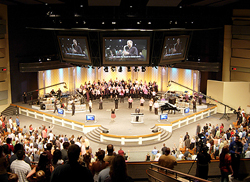About once a month, I get to mix for what I call an “extravaganza” of musical performance. Our worship leader refers to it as “sound by the pound.”
The event can consist of a brass section with 10-12 players (trumpet, trombone, saxophone, and tuba), as well as a string section of a few players sprinkled with a few woodwinds, and then a rhythm section that includes lead guitar, acoustic guitar, keyboard(s) bass, drums, aux percussion. Oh, l almost forgot the B3 player complete with Leslie cabinet!
This is topped of with a 60-plus member choir and a handful of vocal soloists. The best way I can come up with to describe the musical style is “big band meets Bill Gaither.” In fact, the horn section regularly plays for Gaither events.
If you’ve been doing sound for even a little bit, you can already envision some of the potential problems. A recent hymn sing/concert with this group presented some of those problems (er, I mean challenges), such as:
1) How to get the violin, flute and clarinet player (only one of each) above the five brass and four saxophone players?
2) How to get the choir above all of the instrumentation?
3) How to blend the acoustic sound with the amplified sound? (Quick note – the room is only 1,200 seats and a trumpet easily can carry it without any amplification.)
4) What about all of the stage volume?
5) How to keep track of all of the vocal solos?
6) How to nicely tell the lead guitar player that a little less stage volume will actually allow me to fit him into the mix rather than having to mix around him?
To answer a number of the questions: stage layout makes a huge difference.
First, I isolated the choir as much as possible from the instrumentation by placing them on the opposite side of the stage.
Second, I put the violin, flute and clarinet directly in front of the choir, again trying to isolate them from the brass.
Third, although I mic’d the brass, I didn’t put much of them in the mix (in fact, I built the mix around them), with the mics primarily for solos.
Finally, I lumped the brass together, pointed straight out at the audience, to avoid as much spill as possible into the choir mics. The rhythm section was behind and in front of the horns section, opposite the choir.
Is it ideal to have the percussion next to the choir? No, but based on the size of the stage, input locations, and request of the worship leader, we made it work. Thankfully, the drummer was actually a percussionist (meaning he has talent) and played with great dynamics, keeping the spill into the choir mics to a minimum.
Although it’s a well-published fact that I’m not a fan of drum shields, this would have been a great place to use one.
Beyond stage layout, working with musicians who understand the problems that excessive stage volume can create is very helpful.
Also, limiting the amount of open monitor wedges and keeping their level to a minimum is helpful, and properly deployed in-ear monitors would also help.
Finally, using mute groups and keeping hands on the mix console is a must! Managing the number of open mics—and making sure that the choir mics are on only when needed—is critical.
The event made for a busy nigh, but thanks to a worship leader that lets me assist in stage layout, it was a very successful night.
Gary Zandstra is a professional AV systems integrator with Parkway Electric and has been involved with sound at his church for more than 25 years.


















